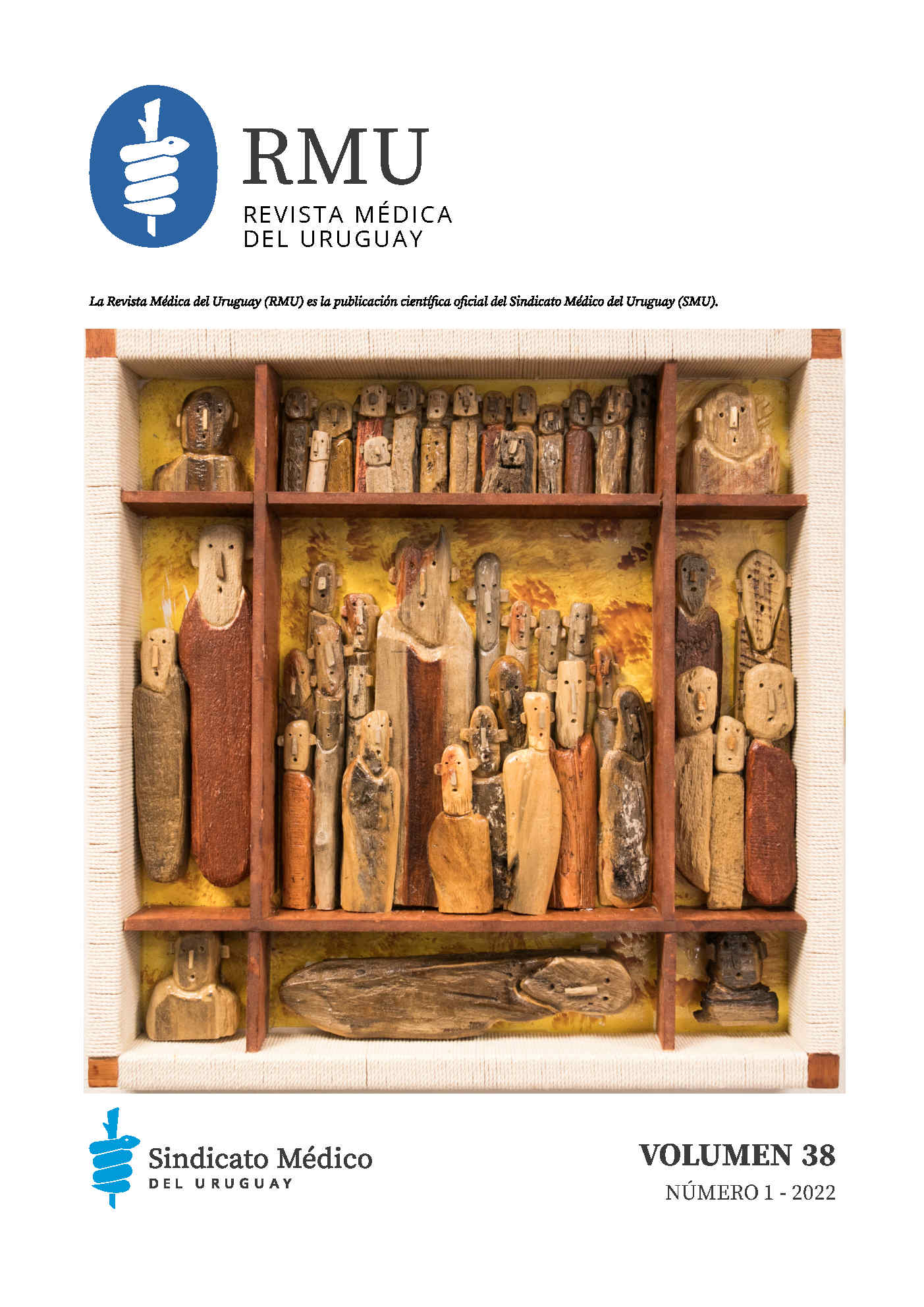Work stress among intensivists in Uruguay
Abstract
Introduction: Work Stress (WS) is generated by interactions and experiences with other people in the work environment. In the Intensive Care Unit (ICU), the physician´s relationship with critical patients, and with their families, the work team and performing invasive procedures, have been identified as stress development factors. This study aims to explore stress levels, and to define the factors associated to work stress.
Methods: in 2018, an online survey was sent to physicians working in the ICU. Stress levels were assessed using Wolfgang’s Health Professionals Stress Inventory (HPSI) and the Stress Symptom Scale.
Results: 96 responses by intensive care physicians were analysed. Average work experience was 11 (6-22.75) years. Intensivists workload is 48 hours a week at the ICU (36-60), 24 (12-24) of which were night shift hours. The total stress level was 53 (44-65) points. Stress levels found were: 5% minimal, 63% moderate and 32% high. A weekly workload greater than 40 hours was associated to the development of severe WS. Higher WS scores were seen in younger physicians.
Conclusions: physicians working in the ICU frequently showed high levels of WS. This study identified the factors associated to its development. A recommendation is made to design strategies and policies that reduce the impact of WS on ICU physicians.
References
2) Embriaco N, Azoulay E, Barrau K, Kentish N, Pochard F, Loun-dou A, et al. High level of burnout in intensivists: prevalence and associated factors. Am J Respir Crit Care Med 2007; 175(7):686-92. doi: 10.1164/rccm.200608-1184OC.
3) Azoulay E, Timsit J, Sprung C, Soares M, Rusinová K, Lafabrie A, et al. Prevalence and factors of intensive care unit conflicts: the conflicus study. Am J Respir Crit Care Med 2009; 180(9):853-60. doi: 10.1164/rccm.200810-1614OC.
4) Cladellas-Pros R, Castelló-Tarrida A, Parrado-Romero E. Satis-facción, salud y estrés laboral del profesorado universitario se-gún su situación contractual. Rev Salud Pública (Bogotá) 2018; 20(1):53-9. doi: 10.15446/rsap.V20n1.53569.
5) Navinés R, Martín-Santos R, Olivé V, Valdés M. Estrés laboral: implicaciones para la salud física y mental. Med Clin (Barc) 2016; 146(8):359-66. doi: 10.1016/j.medcli.2015.11.023.
6) Wolfgang A. The Health Professions Stress Inventory. Psychol Rep 1988; 62(1):220-2. doi: 10.2466/pr0.1988.62.1.220.
7) Robles V, Armendáriz A, Molina O. Afrontamiento al estrés en enfermeras de Unidad de Cuidados Intensivos. Desarrollo Cien-tif Enferm 2012; 20(5):160-3.
8) Palacios Nava M, Morán Álvarez I, Paz Román M. Validación del inventario de Wolfgang en médicos mexicanos: medición del es-trés laboral en hospitales. Rev Mex Sal Trab 2014; 6(16):62-8.
9) Burghi G, Lambert J, Chaize M, Goinheix K, Quiroga C, Fariña G, et al. Prevalence, risk factors and consequences of severe burnout syndrome in ICU. Intensive Care Med 2014; 40(11):1785-6. doi: 10.1007/s00134-014-3454-x.
10) Garrouste-Orgeas M, Perrin M, Soufir L, Vesin A, Blot F, Maxime V, et al. The Iatroref study: medical errors are associ-ated with symptoms of depression in ICU staff but not burnout or safety culture. Intensive Care Med 2015; 41(2):273-84. doi: 10.1007/s00134-014-3601-4.
11) Embriaco N, Hraiech S, Azoulay E, Baumstarck-Barrau K, Forel J, Kentish-Barnes N, et al. Symptoms of depression in ICU physicians. Ann Intensive Care 2012; 2(1):34. doi: 10.1186/2110-5820-2-34.
12) Białek K, Sadowski M. Level of stress and strategies used to cope with stress by physicians working in intensive care units. Anaesthesiol Intensive Ther 2019; 51(5):361-9. doi: 10.5114/ait.2019.90473.
13) Faraji A, Karimi M, Azizi S, Janatolmakan M, Khatony A. Occupational stress and its related demographic factors among Iranian CCU nurses: a cross-sectional study. BMC Res Notes 2019; 12(1):634. doi: 10.1186/s13104-019-4674-5.
14) Şanlıtürk D. Perceived and sources of occupational stress in intensive care nurses during the COVID-19 pandemic. Inten-sive Crit Care Nurs 2021; 67: 103107. doi: 10.1016/j.iccn.2021.103107.
15) Mokhtari R, Moayedi S, Golitaleb M. COVID-19 pandemic and health anxiety among nurses of intensive care units. Int J Ment Health Nurs 2020; 29(6):1275-7. doi: 10.1111/inm.12800.
16) Baye Y, Demeke T, Birhan N, Semahegn A, Birhanu S. Nurses’ work-related stress and associated factors in govern-mental hospitals in Harar, Eastern Ethiopia: a cross-sectional study. PLoS One 2020; 15(8):e0236782. doi: 10.1371/journal.pone.0236782.
17) Sok S, Sim H, Han B, Park S. Burnout and related factors of nurses caring for DNR patients in intensive care units, South Korea. Int J Environ Res Public Health 2020; 17(23):8899. doi: 10.3390/ijerph17238899.
18) Piers R, Azoulay E, Ricou B, Dekeyser Ganz F, Decruye-naere J, Max A, et al. Perceptions of appropriateness of care among European and Israeli intensive care unit nurses and physicians. JAMA 2011; 306(24):2694-703. doi: 10.1001/jama.2011.1888.
19) Jones G, Hocine M, Salomon J, Dab W, Temime L. Demo-graphic and occupational predictors of stress and fatigue in French intensive-care registered nurses and nurses’ aides: a cross-sectional study. Int J Nurs Stud 2015; 52(1):250-9. doi: 10.1016/j.ijnurstu.2014.07.015.

This work is licensed under a Creative Commons Attribution-NonCommercial 4.0 International License.













